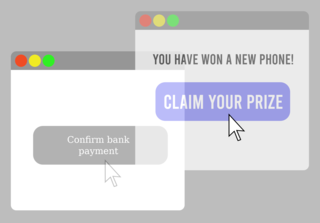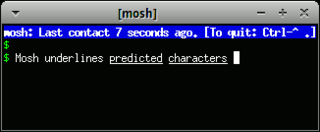Related Research Articles

Telnet is an application protocol used on the Internet or local area network to provide a bidirectional interactive text-oriented communication facility using a virtual terminal connection. User data is interspersed in-band with Telnet control information in an 8-bit byte oriented data connection over the Transmission Control Protocol (TCP).

The World Wide Web (WWW), commonly known as the Web, is the world's dominant software platform. It is an information space where documents and other web resources can be accessed through the Internet using a web browser. The Web has changed people's lives immeasurably. It is the primary tool billions of people worldwide use to interact on the Internet.

A web browser is application software for accessing the World Wide Web or a local website. When a user requests a web page from a particular website, the web browser retrieves the necessary content from a web server and then displays the page on the user's device.

A web server is computer software and underlying hardware that accepts requests via HTTP or its secure variant HTTPS. A user agent, commonly a web browser or web crawler, initiates communication by making a request for a web page or other resource using HTTP, and the server responds with the content of that resource or an error message. A web server can also accept and store resources sent from the user agent if configured to do so.
The File Transfer Protocol (FTP) is a standard communication protocol used for the transfer of computer files from a server to a client on a computer network. FTP is built on a client–server model architecture using separate control and data connections between the client and the server. FTP users may authenticate themselves with a clear-text sign-in protocol, normally in the form of a username and password, but can connect anonymously if the server is configured to allow it. For secure transmission that protects the username and password, and encrypts the content, FTP is often secured with SSL/TLS (FTPS) or replaced with SSH File Transfer Protocol (SFTP).

In computer networking, a proxy server is a server application that acts as an intermediary between a client requesting a resource and the server providing that resource.
SOCKS is an Internet protocol that exchanges network packets between a client and server through a proxy server. SOCKS5 optionally provides authentication so only authorized users may access a server. Practically, a SOCKS server proxies TCP connections to an arbitrary IP address, and provides a means for UDP packets to be forwarded.
IPX/SPX stands for Internetwork Packet Exchange/Sequenced Packet Exchange. IPX and SPX are networking protocols used initially on networks using the Novell NetWare operating systems, and also became widely used on networks deploying Microsoft Windows LANS, as they replaced NetWare LANS, but is no longer widely used. IPX/SPX was also widely used prior to and up to Windows XP era, that supported the protocols, while later Windows versions do not, and TCP/IP took over for networking.
RealVNC is a company that provides remote access software. The software consists of a server and client application for the Virtual Network Computing (VNC) protocol to control another computer's screen remotely.

In computer networking, port forwarding or port mapping is an application of network address translation (NAT) that redirects a communication request from one address and port number combination to another while the packets are traversing a network gateway, such as a router or firewall. This technique is most commonly used to make services on a host residing on a protected or masqueraded (internal) network available to hosts on the opposite side of the gateway, by remapping the destination IP address and port number of the communication to an internal host.
OpenVPN is a virtual private network (VPN) system that implements techniques to create secure point-to-point or site-to-site connections in routed or bridged configurations and remote access facilities. It implements both client and server applications.
Representational state transfer (REST) is a software architectural style that was created to guide the design and development of the architecture for the World Wide Web. REST defines a set of constraints for how the architecture of an Internet-scale distributed hypermedia system, such as the Web, should behave. The REST architectural style emphasises the scalability of interactions between components, uniform interfaces, independent deployment of components, and the creation of a layered architecture to facilitate caching components to reduce user-perceived latency, enforce security, and encapsulate legacy systems.

Google Analytics is a web analytics service offered by Google that tracks and reports website traffic, currently as a platform inside the Google Marketing Platform brand. Google launched the service in November 2005 after acquiring Urchin.
Intego is a Mac and Windows security software company founded in 1997 by Jean-Paul Florencio and Laurent Marteau.

HTTP cookies are small blocks of data created by a web server while a user is browsing a website and placed on the user's computer or other device by the user's web browser. Cookies are placed on the device used to access a website, and more than one cookie may be placed on a user's device during a session.
This page is a comparison of notable remote desktop software available for various platforms.

Clickjacking is a malicious technique of tricking a user into clicking on something different from what the user perceives, thus potentially revealing confidential information or allowing others to take control of their computer while clicking on seemingly innocuous objects, including web pages.

In computing, Mosh is a tool used to connect from a client computer to a server over the Internet, to run a remote terminal. Mosh is similar to SSH, with additional features meant to improve usability for mobile users. The major features are:

IPFire is a hardened open source Linux distribution that primarily performs as a router and a firewall; a standalone firewall system with a web-based management console for configuration.
A virtual private network (VPN) service provides a proxy server to users to bypass Internet censorship such as geoblocking or users who want to protect their communications against data profiling or MitM attacks on hostile networks.